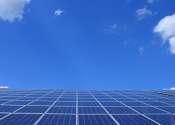Photovoltaics (PV) is a method of generating electrical power by converting solar radiation into direct current electricity using semiconductors that exhibit the photovoltaic effect. Photovoltaic power generation employs solar panels composed of a number of solar cells containing a photovoltaic material. Materials presently used for photovoltaics include monocrystalline silicon, polycrystalline silicon, amorphous silicon, cadmium telluride, and copper indium gallium selenide/sulfide. Due to the growing demand for renewable energy sources, the manufacturing of solar cells and photovoltaic arrays has advanced considerably in recent years.
Solar photovoltaics is growing rapidly, albeit from a small base, to a total global capacity of 40,000 MW at the end of 2010. More than 100 countries use solar PV. Some 24 GW of solar is projected in November 2011 to be installed in that year, pushing up worldwide capacity to roughly 64 GW. Installations may be ground-mounted (and sometimes integrated with farming and grazing) or built into the roof or walls of a building (building-integrated photovoltaics).
Driven by advances in technology and increases in manufacturing scale and sophistication, the cost of photovoltaics has declined steadily since the first solar cells were manufactured. Net metering and financial incentives, such as preferential feed-in tariffs for solar-generated electricity, have supported solar PV installations in many countries.









